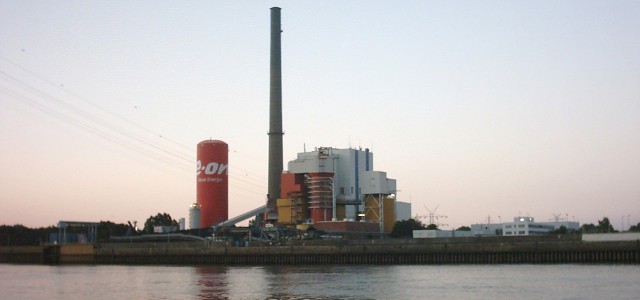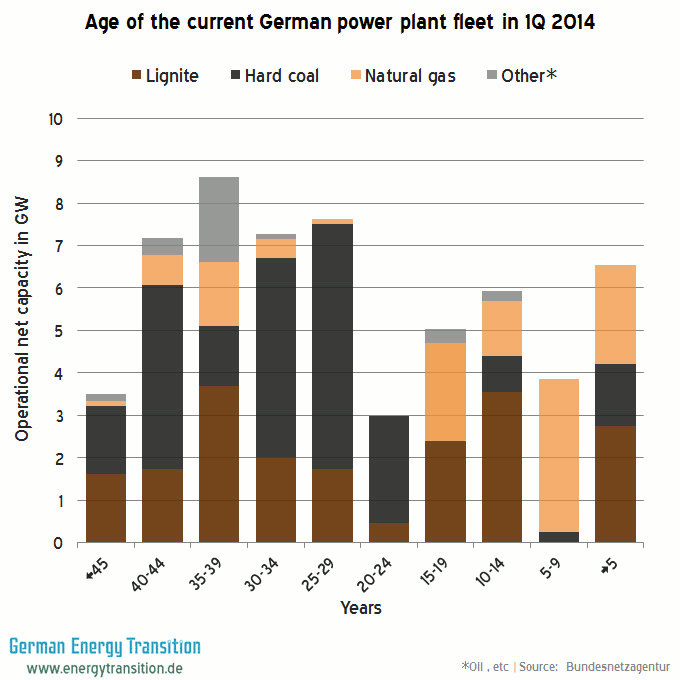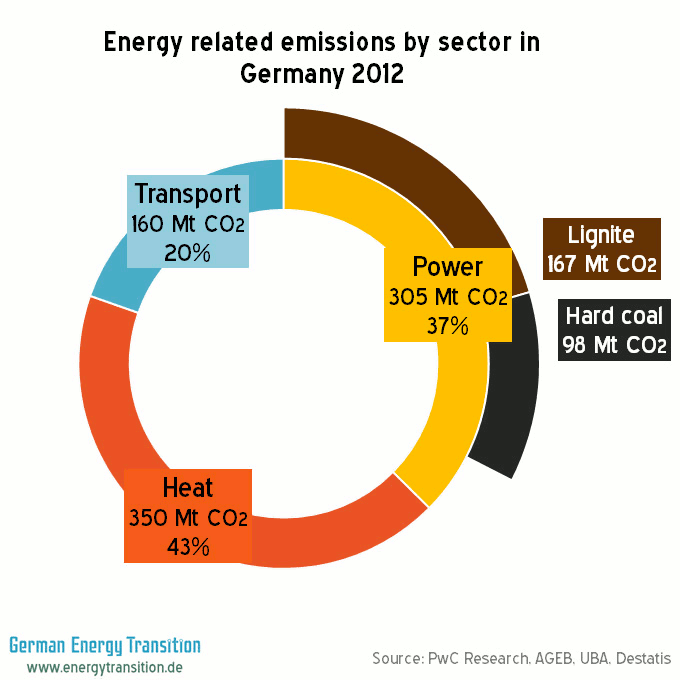It’s really gone too far: German Energy Secretary Sigmar Gabriel’s already minimal attempt to save Germany’s 2020 climate target of reducing emissions by 40% compared with 1990 levels has been watered down further so that it is barely recognizable as a coherent climate policy. Lili Fuhr takes a look at the German coal discussion.

This German coal power plant in Bremen went on grid the same year mankind landed on the moon: 1969. The German government keeps this almost 50 year old polluter running. (Photo by Presse03, CC BY-SA 3.0)
Secretary Gabriel’s suggestion to introduce a ‘climate levy’ on older coal-fired power plants has sparked a fierce controversy in Germany. Industry can choose whether to pay the levy (i.e. buying European Emissions Trading (EU ETS) allowances at a fixed price) or shut down production when they reach the limit of free emission allowances. The policy is supposed to close a gap of 22 million tons of CO2 so that Germany can still reach its 2020 climate target. While NGOs see the proposal as the absolute minimum of what needs to happen (having calculated the size of the gap as 100 million tons of CO2 and not 22 million), the coal industry, the trade unions and many of Secretary Gabriel’s party and government coalition colleagues have been stoking fears about potential job losses if the oldest lignite plants have to close.
or shut down production when they reach the limit of free emission allowances. The policy is supposed to close a gap of 22 million tons of CO2 so that Germany can still reach its 2020 climate target. While NGOs see the proposal as the absolute minimum of what needs to happen (having calculated the size of the gap as 100 million tons of CO2 and not 22 million), the coal industry, the trade unions and many of Secretary Gabriel’s party and government coalition colleagues have been stoking fears about potential job losses if the oldest lignite plants have to close.
The online magazine Klimaretter (‘Climate Savers’) presents a wonderfully thorough analysis (in German) of Federal Ministry of Economic Affairs and Energy (BMWI) current working paper. What is astonishing is how a policy instrument that originally was intended to shut down the dirtiest lignite power stations has morphed into a proposal that aims to prevent even a single decommissioning! A capitulation like this cannot be explained by the power of the coal lobby alone: Such a thing does not happen without the knowledge and involvement of the Chancellery. No signs remain of the ‘Climate Chancellor’ that Merkel impersonated at the Petersberger Climate Dialogue. In an interview with the newspaper „Sueddeutsche Zeitung“ (in German) Merkel openly welcomed Gabriel’s investigations into alternatives to the climate levy – which demonstrates her missing support.
The most important proposed changes to the first draft include:
- Significantly raising the deductible amount of CO2 emissions (exempted from the levy) – from 3 to 3.8 million tons of CO2 per gigawatt of installed capacity;
- Linking the voluntary climate fee to the price of electricity. Meaning: above certain price levels for electricity and CO2 emissions certificates, the climate contribution could be nil.
- Detailed regulations are supposed to ensure that the voluntary climate fee will not lead to shutdowns, even in ‘atypical situations’. ‘Atypical’ for the Ministry would be if, for example, lignite had to be transported over long distances leading to higher transportation costs. Jörg Staude comments: “Here the madness is intentional: Transporting lignite such a long distance is really a losing battle in terms of energy performance. But politically it will be allowed;”
- Keeping 1 to 2 gigawatts of lignite in the capacity reserves, if need be. This clearly translates into a subsidy for the industry.
The outcome: The voluntary climate levy will no longer save 22 million tons of CO2 – but rather only 16 million. The rest, according to the Ministry, is to be saved by cogenerating heat and power, and by counting on the transportation sector (through such novelties as e-highways!).
This raises a lot of questions. Here are just a few of them:
 Why have the additional potential savings in other sectors not yet dawned on Secretary Gabriel before he drafted the proposal? Germany could save more than 22 million tons of CO2!
Why have the additional potential savings in other sectors not yet dawned on Secretary Gabriel before he drafted the proposal? Germany could save more than 22 million tons of CO2!- Why should we rely on such an uncertain instrument, such as emissions trading, for such an important policy goal?
- Why is the non-decommissioning of climate killers an explicit policy goal?
Oliver Krischer’s (Green MP of the German Parliament) ironic commentary seems very apt here:
“It seems to be just a matter of time until the current CDU/CSU-SPD government coalition will also want to take into account the CO2 savings from electric toy racetracks, so that lignite power stations can continue to operate. In the end, the interests of RWE and Vattenfall [two of Germany’s major utilities] with their old coal-fired plants are more important than protecting the climate.”
By the way: The trade union IGBCE (for the chemical, mining and energy sectors), representing the interest of the coal workers, has proposed to introduce a “scrapping bonus” to replace old oil-based heating systems in homes with more efficient ones that use natural gas – and to get rid of the climate levy all together.
Lili Fuhr is head of the Department Ecology and Sustainable Development at the Heinrich Böll Foundation in Berlin. She is a regular blogger for Klima der Gerechtigkeit (in German).
This text first appeared on the GES Blog.
Halo McFly – Why is Germany Closing working Nuclear plants with Little to NO CO2 – and keeping 50 year old coal plants running? Anyone really concerned about the envirnoment and reading more than the Bild might figure it out as we pass 400 PPM.
Good to see the Chinesse just raised 273 BILLION for Nuclear and Long term planning. Not sure if such thinking or discussion is allowed in Germany with the Ecco PC Police…
Two elements are well worth remembering in this context:
1. High officials from the union IGBCE took position in the SPD ranks after the last elections, in particular the SPD general secretary Yasmin Fahimi. There was total agreement between IGBCE and RWE on not wanting old, dirty power stations, to be decomissions. Job losses would be high among union members as this sector his a union stronghold.
2. RWE is still owned to a large degree by municipalities in the German state of North-Rhine-Westphalia (NRW). RWE is based on lignite power stations. Last year RWE announced massive losses for 2013, a first in the company’s long history. Such losses immediately affect municipalities depending on dividends from RWE – and most of those are governed by SPD. If Gabriel hurts them, he loses all chances in the next general elections. This is also why he deformed the EEG (renewable energies act) in the review in 2014, punishing, in particular, auto-consumption.
Job losses in the renewables sector, particularly solar and bio, seem to be of less importance to Gabriel. Unions like IGBCE are notoriously weak in the renewables industry.
It may be madness, yet there’s method in it: what makes no sense for climate change makes excellent sense in Gabriel’s fight for power.
Hi Craigster,
Germany is closing down nuclear plant because we are not suicidal (at least we learnt that lesson from history, 3 Mile-Island, Tschernobyl, Fukushima, and all the other “cannot really happen near misses”). And besides: nuclear power is not CO2-free. The carbon foot-print is about as big as that of natural gas in conventional power plants.
And if you want to be polemical, use your clear name, not some fancy pseudonym to hide behind.
Sunny greetings …
I’m not sure whether such a policy will lead to the expected CO2 savings. What does it bring if old coal fired power plants will be closed and the power will be generated in “new” fossil fired power plants? Okay since new power plants usually work more efficient than old one little quantities of CO2 will be saved by such an activity but 22 million tonnes respectively 16 million are not a little amount. I believe the impact of such a levy will be more economical at first instance. Since the ratio of supply and demand will be changed the power prices at the stock exchange will go up. A climate levy will also have an impact on the power export. In so far a climate levy will be positive since it helps to maintain the power markets which is quite necessary and at the final end will also have a positive impact on the climate in the long run.